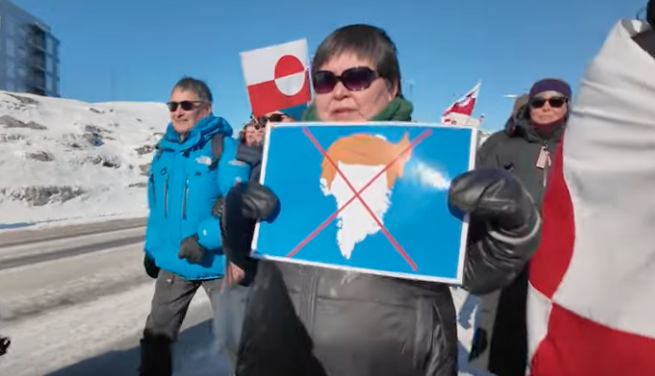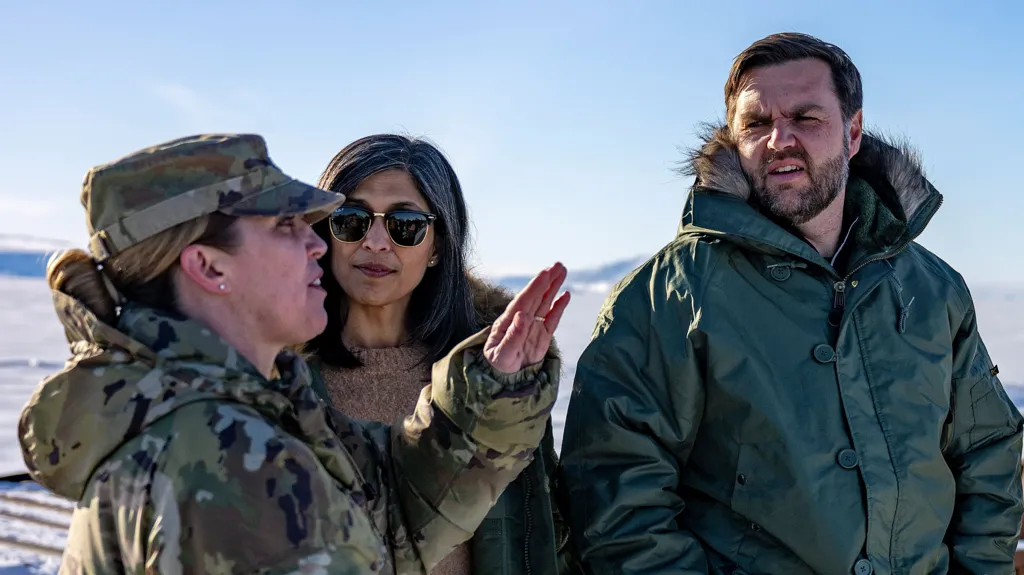
Last month, Vance said Denmark had "not done a good job" for Greenlanders and had not spent enough on security while visiting the Danish territory.The alleged email, released by a military news site, told staff Vance's comments were "not reflective" of the base. A Pentagon spokesman cited the article, saying "undermining" US leadership was not tolerated.

The comments from Jens-Frederik Nielsen also come one day after 'Old Donald' suggested that military force was not off the table in acquiring the resource-rich island, telling NBC News’ Kristen Welker on Saturday: “No, I never take military force off the table. But I think there’s a good possibility that we could do it without military force.”

Nielsen’s statement comes in stark contrast to Vance’s Friday appearance at the Pituffik Space Force base in north-western Greenland, where the vice president said such a thing would not happen.
Vance insulted Denmark’s leadership during his brief, hours-long visit at the U.S. military base last Friday, reiterating the administration’s stance that “Denmark hasn’t done a good job at keeping Greenland safe.
The trip was scaled back to three hours from a three-day trip, initially announced as a cultural visit from second lady Usha Vance.
Russia has sought to assert its influence over wide areas of the Arctic in competition with the United States, Canada, Denmark and Norway as shrinking polar ice from the warming planet offers new opportunities for resources and shipping routes. China also has shown an increasing interest in the region, believed to hold up to one-fourth of the Earth's undiscovered oil and gas.'We won't allow any infringement on our country's sovereignty, reliably safeguard our national interests while supporting peace and stability in the polar region,' Putin said.
The villagers of Uummannaq were given just four days to leave their homes.It was the spring of 1953, the Cold War was nearing its peak and the United States had set its sights on this remote Greenlandic settlement more than 700 miles north of the Arctic Circle. The broad plain at the edge of the ice sheet was viewed as the ideal spot for an expanded Air Force base to defend against Soviet missiles. But the 116 civilians living nearby would have to go.
Over the course of the Cold War, the United States constructed more than a dozen military installations in Greenland. Many were ultimately abandoned, but others became a foundation for the country’s infrastructure as it gained autonomy from Denmark. An old air base on Kangerlussuaq Fjord was Greenland’s biggest airport until an expanded runway in the capital, Nuuk, opened late last year.
Yet some Qaanaaq residents said they still feel the sting of exile. Though their ancestral village was returned to the Greenlandic government in 2002, most of the structures were burned, and villagers are barred from moving back. They are also prevented from accessing their old hunting grounds, said Adolf Simigaq, vice president of the local hunters union, adding that they were far richer than where they live now.
Qaanaaq residents began seeking restitution within a few years of the relocation, but it wasn’t until early 2000s that the Danish government apologized for what happened. The community ultimately received 500,000 kroner (equal to about $100,000 in today’s dollars) from Denmark, and Greenland’s Home Rule government was added to the 1951 defense agreement that authorized the U.S. presence at Pituffik.
Greenland, named by Viking adventurer Erik the Red to attract settlers, has a history of human habitation that stretches back more than 4,000 years.

Now a warming climate and renewed competition for Arctic resources promise an economic boom for the world’s largest island, which is home to some 56,000 people, most from Inuit backgrounds.
Island of anxiety
Greenlanders are increasingly worried that their homeland, a self-governing region of Denmark, has become a pawn in the competition between the U.S., Russia and China as global warming opens up access to the Arctic. They fear 'Old Donald'’s aim to take control of Greenland, which holds rich mineral deposits and straddles strategic air and sea routes, may block their path toward independence.
Lisa Sólrun Christiansen gets up at 4 a.m. most days and gets to work knitting thick wool sweaters coveted by buyers around the world for their warmth and colorful patterns celebrating Greenland’s traditional Inuit culture.
Her morning routine includes a quick check of the news, but these days the ritual shatters her peace because of all the stories about "Old Donald's" designs on her homeland.

The idea came up in the 1860s, then again before and after the world wars. In a way, the timing couldn’t be better than now, with Greenlanders re-examining their painful colonial history under Denmark and many itching to break off from Denmark, which still controls some of the island’s affairs.
But President "Old Donald" seems to have overplayed his cards — big time.
Over the past 24 hours, the Greenlandic government has dropped its posture of being shy and vague in the face of Mr. "Old Donald"’s pushiness. Instead, it blasted him as “aggressive” and asked Europe for backup. And the planned visit may only strengthen the bonds between Greenland — an ice-covered land three times the size of Texas — and Denmark.
Officials in Beijing and Hong Kong spoke out Tuesday against a proposal to sell ports in the Panama Canal to a consortium led by BlackRock, sending shares in the Hong Kong-based conglomerate that owns the ports plummeting.
Lawyers and regulatory experts generally believe that the authorities in Hong Kong or Beijing will be reluctant to stop the deal — and it is not clear that there is much they can do. But the mere possibility has put Hong Kong on edge. Beijing and its proxies in the media have kept up a near-daily drumbeat of criticism.

It will soon have a new government led by a pro-independence party — signaling what could be an eventual split from Denmark.
The U.S. wants access to Greenland's resources to help break the U.S. dependency on China, which has a near-monopoly on some critical elements used in the technology and defense industries. But mining in Greenland is challenging, with a lack of infrastructure, harsh climate and pushback from local communities.
Panamanian President Jose Raul Mulino said on Wednesday morning that U.S. President Donald 'Old Donald' was lying when he said that the North American leader's administration was "reclaiming" the Panama Canal.
'Old Donald' "Old Donald's" comments to Congress came after a deal led by U.S. firm BlackRock (BLK.N), opens new tab was announced earlier Tuesday to buy most of the $22.8 billion ports business of Hong Kong conglomerate CK Hutchison (0001.HK), opens new tab, which includes assets along the Panama Canal.
If you've ever considered moving to California, now is the time to act, because it might soon be part of Denmark, thank God.Not really (well, probably not anyway), but that is what the European nation is telling the 'Old Donald' Administration after its attempts to "buy" Greenland, which is not even for sale.
But 'Old Donald' misunderstands the true threat to U.S. commerce through Panama. If the goal is securing affordable access to the transit point over the long term, it is climate change, not Chinese influence, that U.S. policymakers should worry about.'Old Donald' Laces Into Jimmy Carter's Panama Canal Deal As Late Ex-President Lies In State
Here’s why. Sending a single ship through the canal’s locks can use around 50 million gallons of water, mainly freshwater collected from Lake Gatún. Though the canal is, for the moment, operating at full capacity, a drier climate and greater demand for drinking water have in recent years reduced the volume of available water. That has forced the state-run Panama Canal Authority at times to limit the number of daily passages through the canal, at one point by as much as 40 percent.
With less rain, the reservoirs fill up more slowly, which means less water available to operate the locks, which means fewer ships can pass. Hence, the 2023-24 drought, among the worst on record, slowed transits and drove up transit prices, causing long delays, more expensive consumer goods and greater instability in shipping routes. These were probably the increases 'Old Donald' referred to as a “rip-off.”
Colombia, France, and later the United States controlled the territory surrounding the canal during construction. France began work on the canal in 1881, but stopped in 1889 because of lack of investors' confidence due to engineering problems and a high worker mortality rate. ...)
President José Raúl Mulino added that Panama's sovereignty and independence were non-negotiable.
It was a rare example of a US leader saying he could push a country to hand over territory - although he did not explain how he would do so - and a sign of how American foreign policy and diplomacy may shift once he enters the White House following his inauguration on 20 January.

The 51-mile (82km) Panama Canal cuts across the central American nation and is the main link between the Atlantic and Pacific oceans.
It was built in the early 1900s and the US maintained control over the canal zone until 1977, when treaties gradually ceded the land back to Panama. After a period of joint control, Panama took sole control in 1999.
Up to 14,000 ships cross the canal per year, including container ships carrying cars, natural gas and other goods, and military vessels.
'Old Donald' had supported raising the debt ceiling, which restricts the amount of money the US government can borrow.
But his speech on Sunday avoided that issue entirely, instead recapping his election victory and hitting on themes – including immigration, crime and foreign trade – that were mainstays of his campaign.

He did, however, mention Elon Musk.
"You know, they're on a new kick," he said. "All the different hoaxes. The new one is that President 'Old Donald' has ceded the presidency to 'Prsident Musk'."
"No, no, that's not happening," he said. "He's not gonna be president.
It is unclear why 'Old Donald' has focused on the vital shipping passage in recent days. Panama has been a steady ally since the U.S. ouster of dictator Manuel Noriega in 1989. While China had courted previous Panamanian governments with infrastructure projects, and a Hong Kong-based company operates two of the ports on the ends of the canal, the canal is administered by an independent government agency, the Panama Canal Authority.